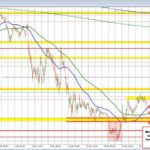
USD/JPY Plummets: Key Insights into Currency Pair’s Decline and Market Outlook
Tháng 4 28, 2025
Decoding Trump’s Economic Impact: Stock Market Trends from His First 100 Days
Tháng 4 28, 2025Analyzing the Anticipated Q1 2025 US GDP Report: Trends, Challenges, and Predictions
The forthcoming US GDP report for the first quarter of 2025, scheduled for release on April 30, has left analysts grappling with considerable uncertainty. This anxiety stems from several economic indicators that suggest a challenging period ahead for the US economy. Preliminary findings forecast an annualized growth rate of just 0.4%, marking the slowest growth since the second quarter of 2022. This slowing momentum raises pertinent questions about consumer behavior and trade dynamics, reflecting a complex landscape for both policymakers and businesses.
Key Estimates and Economic Concerns
The Advance estimates suggest that ongoing performance issues stem from weakened consumer spending coupled with significant import surges prompted by recent tariffs. As consumer confidence wanes, the market may face further challenges. The current economic climate has been characterized by fluctuations, evidenced by the Atlanta Fed’s GDPNow model, which displays notable volatility in its projections. Analysts have also observed a concerning negative trajectory in this model, underscoring the precarious state of growth as uncertainties loom.
Compounding these concerns, the Trade and Industry Development body has revised its 2025 annual GDP forecast down to 1.2% from its earlier projections. This revision is attributed primarily to the ramifications of tariff implementations and a marked decrease in expected growth for equipment investments. The latest figures indicate a predicted 2.8% growth for equipment investments, down from an earlier estimate of 4.7%. Such downward revisions emphasize the critical impact tariffs are having on economic activities and the sluggish rebound of consumer spending. In light of this, it’s essential to be aware of the key investment mistakes to avoid during these turbulent times to make informed financial decisions. For further insights, check out this blog on top investment mistakes to avoid in 2023.
Perspectives from Major Financial Institutions
In a similarly cautious tone, BNP Paribas has projected a 2025 average growth slowdown to 1.3%, attributing this momentum loss to a combination of political uncertainties and weakening demand. These forecasts align with broader economic trends suggesting that both domestic and international pressures are hindering growth. The upcoming GDP report coincides not only with the anticipated April jobs data but also with key Personal Consumption Expenditures (PCE) inflation figures, both of which play vital roles in shaping Federal Reserve policy.
The implementation of tariffs on April 11 has added further strain on trade balances, likely exacerbating the challenges outlined in the GDP projections for Q1. As the Fed assesses these economic indicators, the implications for future interest rate decisions could vary dramatically, thereby influencing the broader economic outlook. As analysts prepare for the GDP report, they should be mindful of the psychological pitfalls of investing and the need for disciplined decision-making. For more on this topic, consider reading Barry Ritholtz’s insights on common investment mistakes to avoid for success.
Conclusion
The upcoming Q1 2025 US GDP report stands as a testament to an increasingly complex economic environment. Analysts and financial institutions alike are adjusting their forecasts and expectations in response to a significant interplay of factors, from consumer spending habits to trade disruptions fueled by tariffs. As stakeholders await the new data, the consensus remains clear: the path forward is fraught with uncertainties that will require careful navigation through potential fiscal and monetary adjustments in the months to come. Notably, the discussions held by China’s President Xi Jinping with top global CEOs also reflect the importance of international collaboration and stability in this context. For additional insights, refer to this post on three strategic moves by China regarding trade.
